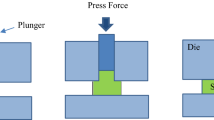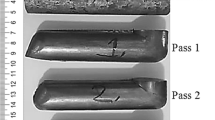Abstract
The results of experiments directed to the optimization of Equal-channel angular pressing (ECAP) die design can be affected by the material response to deformation, thus making difficult to isolate the die performance, particularly with respect to the assessment of strain homogeneity. In the present work, a completely “inert” material was employed for the physical simulation of the ECAP deformation, thus permitting an unequivocal analysis of the die performance. Such material is the Pb–62 %Sn alloy, of which absence of strain hardening, that is, full recrystallization during or after equal-channel angular pressing, was here ascertained. As a consequence, the corner gap effect, a phenomenon known to decrease strain homogeneity, will depend only on die geometry. The study was extended to the case in which the strain distribution depends on both outer (R) and inner (r) curvature radii. Results show that the size of the corner gap is related to the deformation homogeneity of the billet, and the pressing forces are reduced for large outer radii. Emphasis was given to the quantitative measurement of the corner gap size, its relationship with the von Mises strain, and its distribution within the ECAP-processed billet, for different R–r combinations.












Similar content being viewed by others
References
Estrin Y, Vinogradov A (2013) Extreme grain refinement by severe plastic deformation: a wealth of challenging science. Acta Mater 61:782–817
Langdon TG (2007) The processing of ultrafine-grained materials through the application of severe plastic deformation. J Mater Sci 42:3388–3397. doi:10.1007/s10853-006-1475-8
Iwahashi Y, Wang J, Horita Z, Nemoto M, Langdon TG (1996) Principle of equal-channel angular pressing for the processing of ultra-fine grained materials. Scripta Mater 35:143–146
Luis Pérez CJ (2004) On the correct selection of the channel die in ECAP processes. Scripta Mater 50:387–393
Raab GI (2006) Metal flow at equal channel angular pressing with back-pressure. Mater Sci Forum 503–504:739–744
Kawasaki M, Mendes AA, Sordi VL, Ferrante M, Langdon TG (2011) Achieving superplastic properties in a Pb–Sn eutectic alloy processed by equal-channel angular pressing. J Mater Sci 46:155–160. doi:10.1007/s10853-010-4889-2
Leo P, Cerri E, De Marco PP, Roven HJ (2007) Properties and deformation behaviour of severe plastic deformed aluminium alloys. J Mater Process Technol 182:207–214
Kim HS, Seo MH, Hong SI (2000) On the die corner gap formation in equal channel angular pressing. Mater Sci Eng A291:86–90
Karpuz P, Simsir C, Gür CH (2009) Investigating the effects of hardening of aluminium alloys on equal-channel angular pressing—a finite-element study. Mater Sci Eng A503:148–151
Duan ZC, Langdon TG (2011) An experimental evaluation of a special ECAP die containing two equal arcs of curvature. Mater Sci Eng A528:4173–4179
Kim HS (2001) Finite element analysis of equal channel angular pressing using a round corner die. Mater Sci Eng A315:122–128
Kim HS (2002) Finite element analysis of deformation behaviour of metals during equal channel multi-angular pressing. Mater Sci Eng A328:317–323
Oh SJ, Kang SB (2003) Analysis of the billet deformation during equal channel angular pressing. Mater Sci Eng A343:107–115
Park J-W, Suh J-Y (2001) Effect of die shape on the deformation behavior in equal-channel angular pressing. Metall Mater Trans A 32A:3007–3014
Sklenicka V, Dvorak J, Kral P, Stonawska Z, Svoboda M (2005) Creep processes in pure aluminium processed by equal-channel angular pressing. Mater Sci Eng A410–411:408–412
Chinh NQ, Szommer P, Csanádi T, Langdon TG (2006) Flow processes at low temperatures in ultrafine-grained aluminium. Mater Sci Eng A434:326–334
Luri R, Leon J, Luis CJ, Puertas I (2004) Mechanical behavior of an Al–Mg alloy processed by ECAE. In: P. Phelan (Ed.) Proceedings of the 21st Int Manufacturing Conference IMC 21, Limerick, Ireland, vol. 1: 167–174
Gazder AA, Li S, Dalla Torre FH, Beyerlein IJ, Gu CF, Davies CHJ, Pereloma EV (2006) Progressive texture evolution during equal channel angular extrusion. Mater Sci Eng A437:259–267
Yang Y-L, Lee S (2003) Finite element analysis of strain conditions after equal channel angular extrusion. J Mater Process Technol 140:583–587
Son I-H, Lee J-H, Im Y-T (2006) Finite element investigation of equal channel angular extrusion with back pressure. J Mater Process Technol 171:480–487
Son IH, Jin YG, Im YT, Chon SH, Park JK (2007) Sensitivity of friction condition in finite element investigations of equal channel angular extrusion. Mater Sci Eng A445–446:676–685
Mendes Filho AA, Sordi VL, Rubert JB, Ferrante M (2008) The influence of ECAP die channel geometry on shear strain and deformation uniformity. Mater Sci Forum 584–586:145–150
Xu S, Zhao G, Ma X, Ren G (2007) Finite elements analysis and optimization of equal channel angular pressing for producing ultra-fine grained materials. J Mater Process Technol 184:209–216
Comaneci R, Zaharia L, Chelariu R (2012) Damaging prediction of difficult-to-work aluminum alloys during equal channel angular pressing. J Mater Eng Perform 21:287–297
Bao L, Ding H, W-j Zhao, R-b Mei (2011) Simulation of multi-pass ECAP by 3D finite element method. Mater Sci Forum 667–669:115–120
Yuan YC, Ma AB, Jiang JH, Yang DH (2011) Finite element analysis of the deformation distribution during multi-pass rotary-die ECAP. J Mater Eng Perform 20:1378–1384
Alhajeri SN, Gao N, Langdon TG (2011) Hardness homogeneity on longitudinal and transverse sections of an aluminum alloy processed by ECAP. Mater Sci Eng A 528:3833–3840
Duan ZC, Chinh NQ, Xu C, Langdon TG (2010) Developing processing routes for the equal-channel angular pressing of age-hardenable aluminum alloys. Metall Mater Trans A41:802–809
Zhao X, Fu W, Yang X, Langdon TG (2008) Microstructure and properties of pure titanium processed by equal-channel angular pressing at room temperature. Scripta Mater 59:542–545
Acknowledgements
This work was supported by the São Paulo State Foundation for Research Funding (FAPESP 2014/15091-4) and by the National Council of Scientific and Technological Development (CNPq449009/2014-9).
Author information
Authors and Affiliations
Corresponding author
Ethics declarations
Conflict of Interest
The authors declare that they have no conflict of interest.
Electronic supplementary material
Below is the link to the electronic supplementary material.
Supplementary material 2 (WMV 9755 kb)
Rights and permissions
About this article
Cite this article
Sordi, V.L., Mendes Filho, A.A., Valio, G.T. et al. Equal-channel angular pressing: influence of die design on pressure forces, strain homogeneity, and corner gap formation. J Mater Sci 51, 2380–2393 (2016). https://doi.org/10.1007/s10853-015-9547-2
Received:
Accepted:
Published:
Issue Date:
DOI: https://doi.org/10.1007/s10853-015-9547-2




